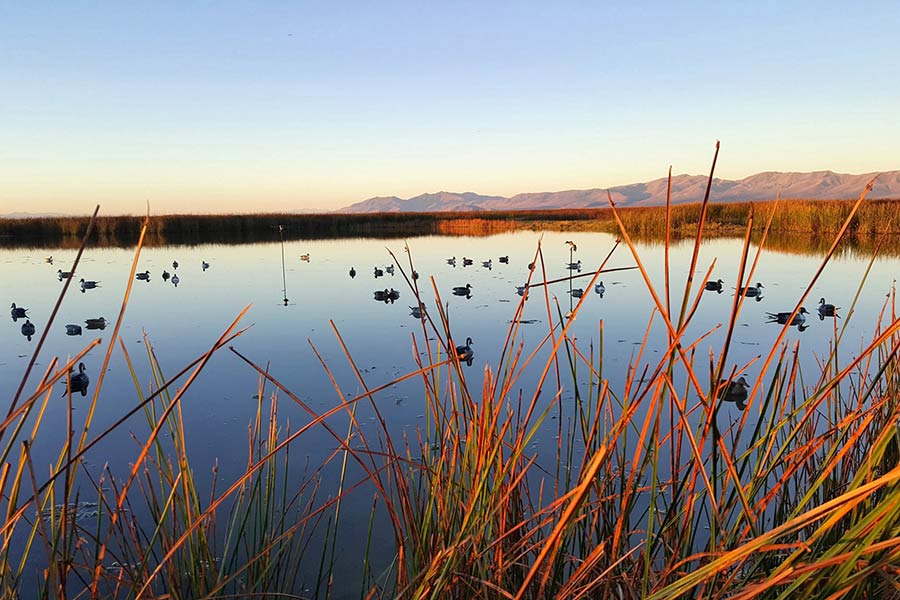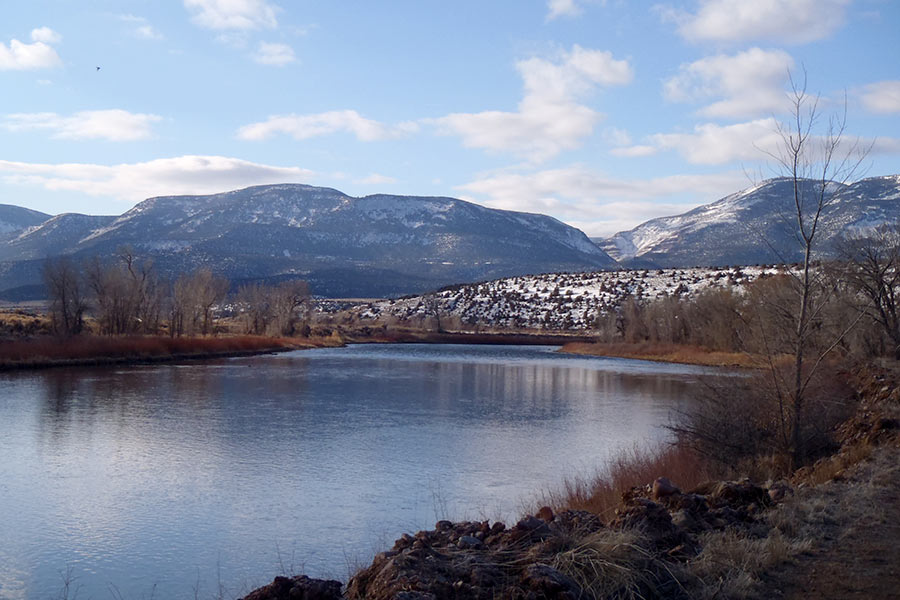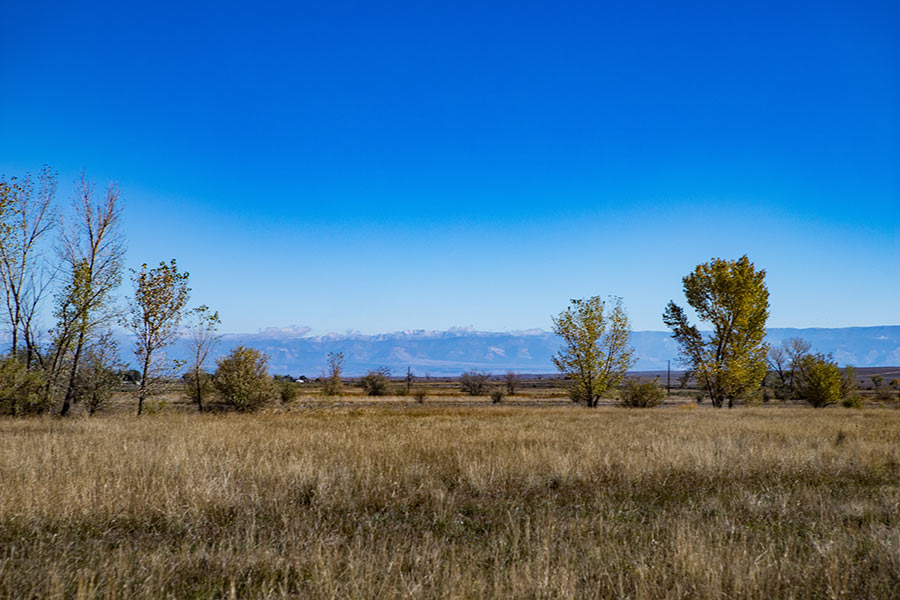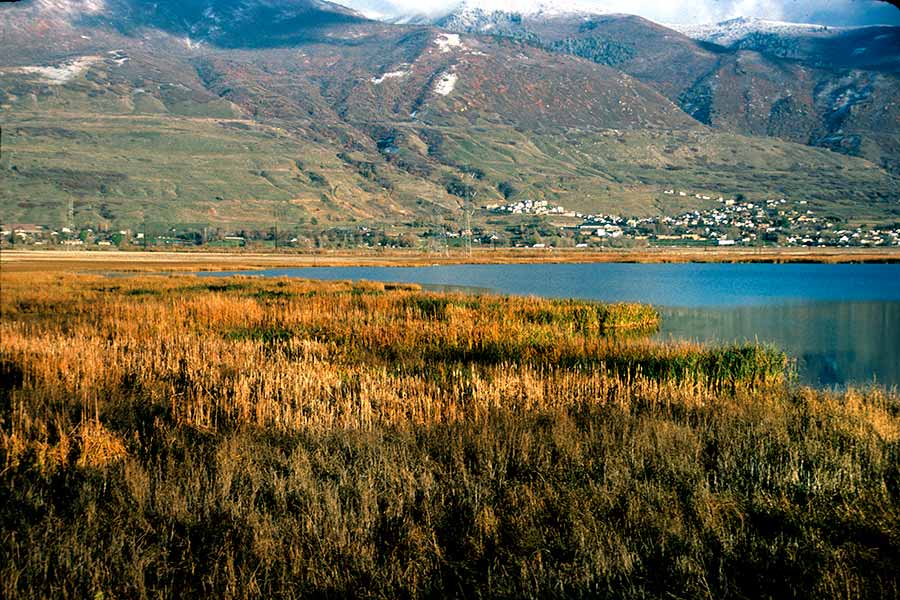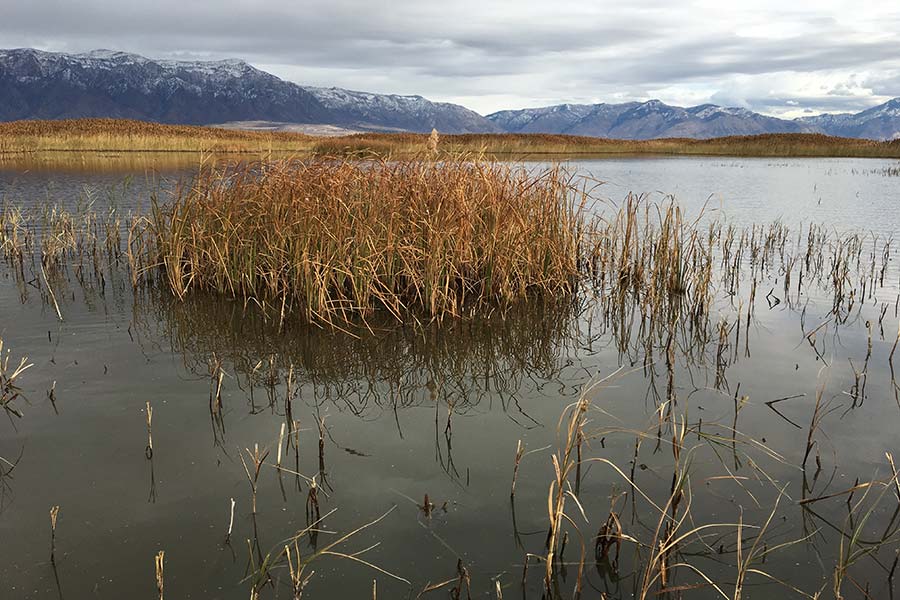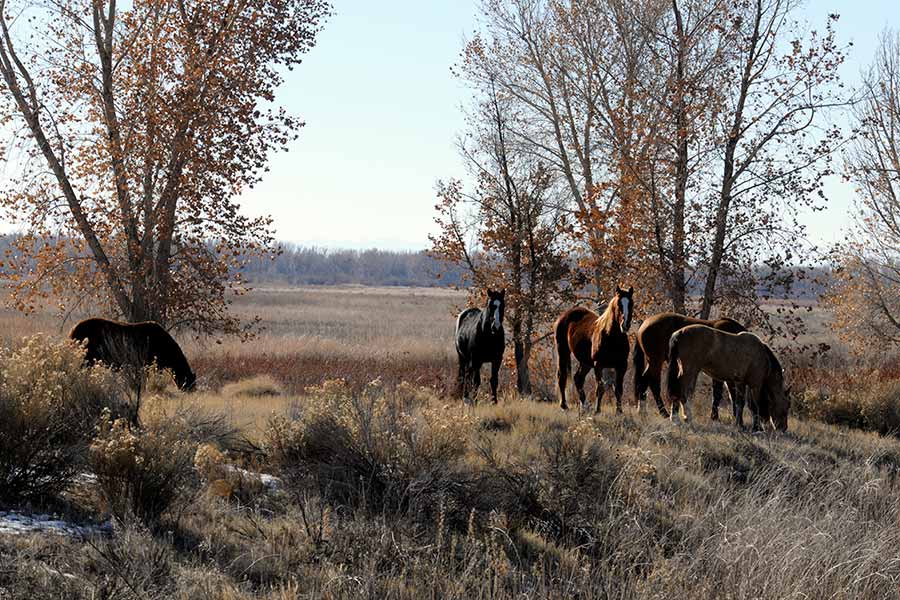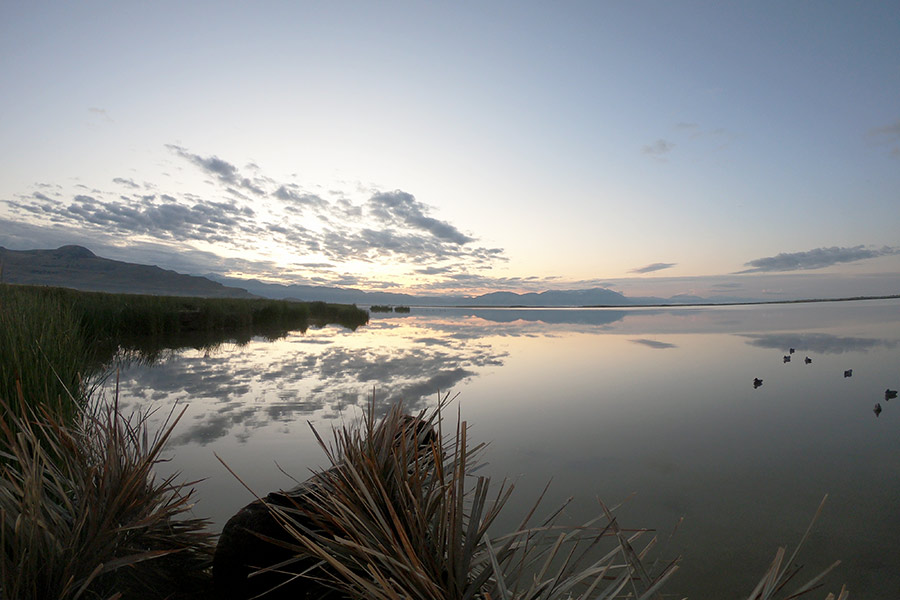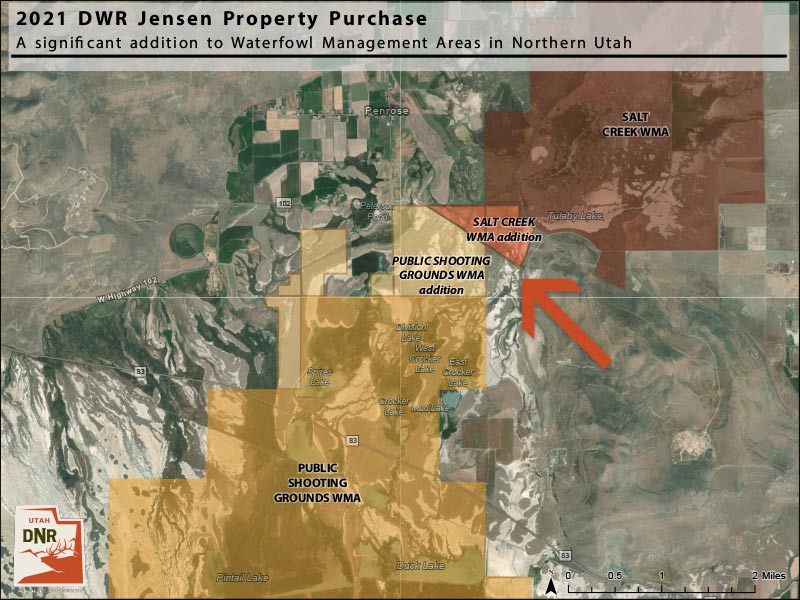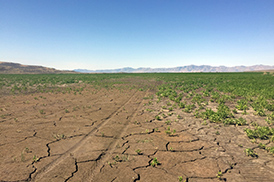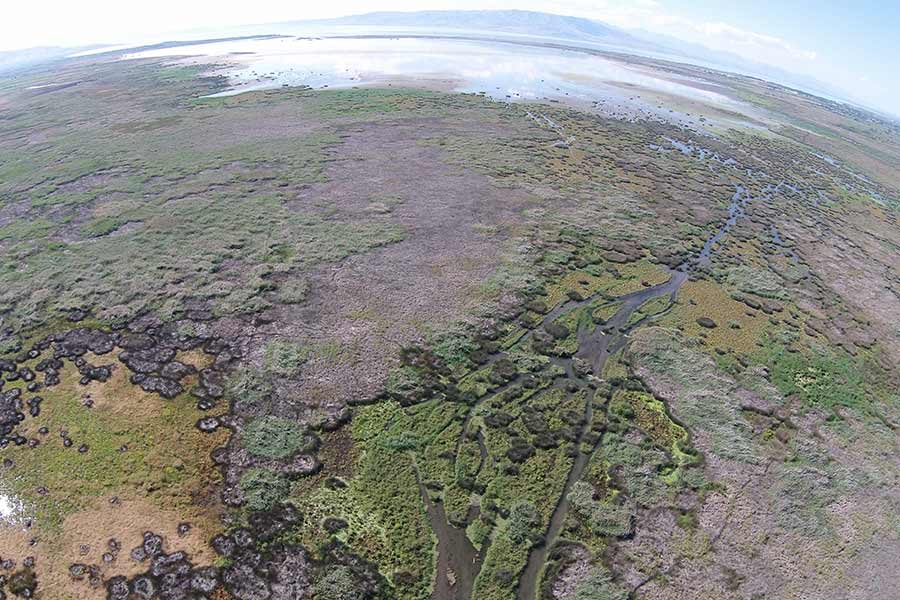Waterfowl hunt opener conditions
Conditions at specific waterfowl areas
The following areas are open to waterfowl hunting as of mid-September 2021. Tap or click each area to view its conditions:
Bear River Bay
Bear River Bay has been dry all summer. It is unknown when water will be available for this area. Water levels in the area depend on Great Salt Lake water levels (which are currently at an all-time low) and water released from the Bear River Migratory Bird Refuge.
Bear River Migratory Bird Refuge
Marsh conditions: August rains have allowed the refuge to direct water into a few of the hunt units. As of the end of August, Unit 2d is at fall target level and Units 2c, 3b, and 1a are filling. Water will be directed into other areas as it becomes available. Because of a new water control structure project in Units 5c and 5d, the Refuge is unable to put water into unit 6 at this time. Due to continued exceptional drought conditions, water levels are subject to change. Please contact refuge staff for current information.
Access: Access into hunting units is limited to foot, bicycle, motorboats, canoes, kayaks and other self-propelled watercraft. Boats must be launched at designated boat ramps, and air boats are only permitted in open areas of Units 6, 7, 8, 9 and 10.
Waterfowl use: Due to dry conditions, waterfowl numbers may be lower than average on the refuge as they move around the Great Salt Lake area to find suitable habitat.
General information: Units open to hunting can be found in the Bear River Migratory Bird Refuge hunting brochure and are open to coots, ducks, geese, tundra swans and pheasants. There is no hunting or shooting permitted within 100 yards of refuge roads, the D Line dike, parking areas and observation platforms. Hunters may enter the refuge no earlier than two hours before sunrise and must exit by two hours after sunset during the hunting season. For more detailed information and to see the hunting brochure, visit the refuge website or call 435-723-5887.
Browns Park WMA
Water/marsh conditions: Water levels on the Headquarters and Butch Cassidy units will be lower than usual due to the drought and lower than average water flows down the creeks that feed these units. The Bridgeport Unit will be low due to maintenance issues on a pump. Ponds on the Parsons Unit will be filling up and should be near full capacity by mid-October. River levels are expected to be lower than previous years due to drought conditions and may range from 860 to 1300 cubic feet per second.
Access: Road access from Dutch John to the Bridgeport and Parsons Units is in good condition. The swinging bridge has reopened in Colorado and has a maximum width of 8 feet.
Bird use: Current bird numbers are down due to drought conditions and ponds drying up this summer. Youth hunters should expect to see some birds, which typically decoy well. For the regular season opener, hunters will mostly see mallards, green winged teal, wigeon and gadwall. Hunters should expect to see fewer Canada geese this year.
General information: There may be a closure on the Headquarters Unit to enable swan trapping to occur, but will depend on water levels and swan arrival.
Clear Lake WMA, Topaz Slough WMA, Redmond WMA and Bicknell Bottoms WMA
Water/marsh conditions: The spring flows at Clear Lake have decreased this year, and it has been another long, hot, dry summer. Areas south of the county road have no water except for a small amount coming out of the rest area. Unit 2 is completely dry and will fill as water becomes available much later in the season.
There is no water north of the county road for the beginning of the season. Like last year, water will begin to fill areas as the weather cools down. Areas north of the county road might begin filling around January 1. The west marsh area continues to be dry. Conditions should improve as the season progresses, and more ducks should show up as the amount of water increases with each passing week.
Please remember that Clear Lake is very shallow for boats; only non-motorized boats are allowed in the area.
Marsh conditions at Topaz Slough are completely dry.
Redmond has good conditions on small impoundments and also has foot access to the Sevier River.
Bicknell Bottoms has excellent conditions. Water levels are good, and waterfowl numbers are up this year.
Access: All of the areas allow only non-motorized boats due to shallow water conditions. Camping is allowed in parking lots, and fires are permitted. ATVs are prohibited.
Clear Lake, Redmond and Bicknell Bottoms are all good places to try pheasant hunting. Each area is open for pheasant hunting for 30 days and has excellent habitat for the birds and hunters to enjoy. Please check the current Waterfowl Guidebook for details and shooting hours. If hunters are looking to get away from crowds, try these areas.
Bird use: Clear Lake duck numbers should increase as the season progresses. Good numbers of ducks are expected to show up as soon as the weather turns colder, increasing until they peak around January 1. These ducks begin using flooded annual weeds and can provide some great late season hunting with easy access. The most common ducks at Clear Lake are mallards, pintails and greenwing teal.
Good numbers of ducks and geese can be found at Bicknell Bottoms. Bicknell Bottoms offers good hunting both early season and late season. Pheasants are found there as well as Blue Ribbon trout fishing.
Redmond is generally better for duck hunting earlier in the season, and is becoming a very popular pheasant hunting area.
Clear Lake, Redmond and Bicknell Bottoms all receive planted pheasants each week during the general pheasant hunt.
General information: General season is open Oct. 16–29.
Youth pheasant and quail hunting is open statewide Oct. 30–Nov. 4. The waterfowl season opens Oct. 16 in the Southern Region, as well. Steel shot is required to hunt any species inside Clear Lake and Bicknell Bottoms.
Gunnison Bend Reservoir is a large rest area in the delta. Many waterfowl stay there during the day and fly away eventually to feed in the surrounding agricultural fields. Some success can be found by scouting and asking permission to hunt private lands.
Desert Lake WMA
Water/marsh conditions: Due to dry conditions, several ponds are dry and others very low. Recent rains have helped to add water to most ponds. A couple of ponds retained water for the whole year and should provide good cover and food this fall. Ponds with water are holding birds. A few more good rainstorms could quickly add hunting opportunities.
Access: The ponds can be accessed on the county roads that go through the property. Six parking lots are located along the county roads for waterfowl hunters. No camping is allowed on the Desert Lake Waterfowl Management Area. Please use adjacent Bureau of Land Management property for overnight use.
Bird use: Waterfowl numbers have begun to increase over the last month and should remain steady until the general waterfowl hunt opener. Waterfowl numbers typically go down following the opener until the migration begins. Waterfowl should be present for the youth hunt and they should decoy well. Common species present include widgeon, gadwall, mallard, green-wing teal, redheads and coots.
Farmington Bay WMA, Timpie Springs WMA & Layton-Kaysville WMA
Wetland conditions at Farmington Bay Waterfowl Management Area are fair outside the impounded units and excellent inside the impounded units. Specifically, all units are at hunt level capacity. Unit 1, Unit 2 and Turpin produced large amounts of sago pondweed. The abundance of sago pondweed in our three largest units will provide excellent forage for migrating waterfowl at Farmington Bay.
The habitat in the interior sheet-flow wetlands and impoundments within Farmington Bay is in great condition due to aggressive herbicide treatments and/or cattle grazing on invasive phragmites. For example, over 1200 acres of phragmites were treated northwest of the Turpin Unit during the fall of 2017 and 2018, and the area was mowed and crushed during winter 2018, 2019, 2020 and 2021. In addition, cattle grazed extensively on the northwest side of the Turpin Unit.
These large-scale phragmites and grazing treatments north of Turpin should provide excellent areas for birds to loaf and should provide great hunting access. Phragmites were treated with herbicide on all dike lines and other areas accessible by Marsh Masters, track machines, road vehicles and airboats during August 2021. Improved habitat conditions should encourage excellent bird use at the WMA this year. Cattle and drought-stressing habitats were also used to manage phragmites in many other areas throughout the WMA besides the Turpin Unit in order to improve habitat conditions for waterfowl.
Teal Lake (directly north of the airboat launch and west of the Unit 1 dike) was completed during the summer of 2016. The DWR's waterfowl maintenance crew improved the dike in 2018 by spreading gravel on top of the dike, which has made it more accessible to managers and the public. However, the Teal Lake dike needs immediate improvement and WMA managers were able to put funds together and hire a contractor to repair the dike. Due to time constraints, the contractor was only recently able to start re-construction. Hunters will see construction taking place on Teal Lake this fall and are asked to stay away from equipment and heed closures around construction areas. Teal Lake will not be filled with water by the start of waterfowl hunting season.
Air boating conditions: Conditions in the shallow bays of the Great Salt Lake are worse than last year due to extensive drought. Hunters should consider hazards, multiple changes in vegetation and large expanses of mudflat that exist (and change yearly) outside the diked units in the open waters of Farmington Bay, the Layton-Kaysville wetlands and the Great Salt Lake.
Timpie Springs WMA: Although Timpie Springs WMA is a small wetland complex, marsh conditions and habitat are considered good to excellent. Specifically, Timpie Springs WMA consists of two large impoundments, some sheet-flow wetlands, mudflat, and some areas of upland habitat (totaling 1440 acres). The wetland vegetation is characterized by low standing salt grass and a few bulrush species. Both ponds at Timpie Springs WMA are full and spilling water onto sheet-flow wetlands or surrounding mudflats.
Layton-Kaysville WMA: Marsh conditions at Layton-Kaysville are fair to poor due to phragmites encroachment and low water.
Access: All of the access points to Farmington Bay will be open on Thursday, Sept. 16, by 8 a.m. Boat hunters are encouraged to use the north entrance to launch into Unit 1 and Turpin. Access for small boats is located at the south entrance. Because of submerged hazards, a wakeless boat speed is recommended in all of the freshwater impoundments. Consider how well you'll be able to retrieve birds before you choose a place to hunt.
Access to Timpie Springs WMA is permitted year-round. Access to Gaily wetlands will be open two days prior to the start of the youth hunt, which is Sept. 18.
The DWR no longer manages the Layton-Kaysville access near Rouche Lane in west Farmington (the access is permanently closed). The DWR is working with UDOT on another access point in trade located in west Kaysville, which will provide better access for hunters. However, the parking area and access point will not be completed until after this hunting season.
Bird use: There are currently large numbers of ducks and geese at Farmington Bay. Managers anticipate an increase in bird use and distribution within our impounded wetlands due to good to excellent habitat conditions within them, especially when managers start flooding all sheet-flow wetlands in mid-September. Waterfowl hunters can expect to see large numbers of cinnamon teal, gadwall and pintail early in the season. Diving ducks typically show up later in October. Swans are typically harvested in larger numbers during mid- to late November, while dark goose hunting typically improves during the extended goose hunt.
General information:
- All of the areas listed above are open for hunting.
- The northwest corner of Unit 1 at Farmington Bay is a waterfowl rest area and is closed to hunting and trespassing.
- The area west of the main entrance road, to the first right bend in the road, and north of the road until you get to Goose Egg Island, is closed for research and educational purposes.
- Shooting is prohibited at Farmington Bay within 600 feet of all dikes and any road open to motorized vehicles.
- Airboats are prohibited within diked units.
- The South Crystal Unit is a motorless unit.
- Camping is allowed in parking areas only. Open fires are prohibited. Please clean your campsite so that we can continue to allow camping.
- The hunting blind for hunters with disabilities is by reservation only. Contact Jason Jones at 801-451-7386 for the rules and to make a reservation.
Harold Crane WMA
Marsh conditions: Generally, marsh and impoundment conditions are great. Note the following:
- Main impoundments: There is excellent aquatic vegetation growth in all impoundments.
- Exterior flats: Good conditions on flats to the east. West of the impoundments are beginning to flood.
- Rainbow Unit: Currently, Rainbow Pond is filling with water and should have enough water throughout the hunt. The area north of the Rail Trail (on the east end) also looks good. The area was burned and then grazed by cattle, and has good water.
Access: Gates will open Thursday, Sept. 16. The road accessing the west Rainbow Unit is in good shape, as are the three connected parking lots. The main Harold Crane parking lot has been improved also.
The access channel into the "non-motorized boating only" east unit was cleaned and a boat launch was installed a couple years ago. The channel starts on the west end of the main parking lot.
The Federal Bureau of Reclamation road to Harold Crane through Willard Upland Game Bird Area is in fair shape because of the hard work that the DWR waterfowl maintenance crew has done. The head gate bridges are slightly narrower than the road, so be careful when driving over them.
Bird numbers:
- Main impoundments: Great numbers of both ducks and geese on all impoundments.
- Rainbow Unit: Fair numbers of birds north of the Rail Trail in the phragmites treatment area. Goose numbers are great overall.
General information: Hunting should be great for the youth hunt and general opener if the birds stick around.
Howard Slough WMA
Marsh conditions: Conditions are great in the main impoundments. Water is at full pool/spilling levels and contains great pondweed growth. Some small, seasonal ponds on the Hooper Hot Springs Unit are low and/or dry. The east side impoundment edge was also chemically treated last fall and grazed this summer.
Access: The access road will be graded. Gates will open Thursday, Sept. 16.
Bird numbers: The main impoundments have excellent bird numbers, and many birds can be found in the grazed area. Generally, duck numbers have been holding well above average, and goose and swan numbers have increased substantially over the last few years.
General information: Howard Slough WMA had some of the best youth hunt success in the region over the last few years and should be great again this season. For its size, it holds up very well under heavy hunting pressure. Swan hunting is expected to be good later on in the season, also.
Locomotive Springs WMA
Water/marsh conditions: The water levels are very low and impoundments are dry.
Access: Roads are a little rough. Gates will open Sept. 16.
Bird use: Bird numbers are extremely low. Mallard, pintail and green-winged teal are the primary birds. There are very few Canada geese.
General information: Locomotive Springs WMA is in the northern goose area. Dark goose hunting will be closed Oct. 15–29. Camping is allowed in established parking areas, but there are no facilities available. Please be aware of up-to-date state fire restrictions that may apply and follow them accordingly.
Ogden WMA
Marsh and impoundment conditions:
Unit 1: Pondweed growth is excellent in the main impoundment and secondary impoundments. Screens were maintained on all water control structures that feed the area and managers have done an excellent job of keeping carp from re-invading the area. Over 2,000 acres of phragmites on the east side of the open water have been successfully grazed. The east side of the unit has also been sprayed for phragmites. In the secondary impoundments, grazing pressure has been increased and more acreage has opened up.
On the west side of the unit, thousands of acres have been intensively grazed by cattle, opening up once-overgrown areas. We've excluded cattle from the 500-acre, fenced-off area west of the dike; this area still has decent cover.
Unit 2: Grazing pressure was also increased in this area and phragmites overgrowth was cut back extensively this summer. Currently, there is no water in the area due to the drought.
Unit 3: Pondweed growth is excellent this year, and the stands first put in three years ago have thickened and enlarged. Cattle grazed the east side of the open water, opening overgrown areas.
Be advised that a rest area is in place on Unit 3. The area is well marked, and there is absolutely no trespassing allowed in it. It consists of the two small impoundments on the south side of the road as you head to the Unit 3 boat launch area.
Weber Delta: South Weber Delta was mostly dry this summer and is now in fair condition. Not much water is in the river impoundment, and the east dump basin is low.
Pintail: Cattle have been grazing thousands of acres in the Ogden WMA and have opened up many overgrown areas. Some areas will have been flooded with water by the start of the youth hunt.
Generally, all major impoundments are full and overflowing onto the westward flats. Marsh conditions are good to excellent in most areas. The Great Salt Lake water elevation is currently 4195.0 feet, which is lower than it was one year ago. The lake reached an all-time historic low this summer.
Access: All outer gates to the lower parking lots and boat launches will be open on Thursday, Sept. 16. There is good vehicle access, and most roadways and parking lots are mowed and in good shape. Most access roads will be graded by the general opener.
The Unit 1 and Unit 3 boat channels into main impoundments are clear and usable.
Bird numbers:
Unit 1: Very good bird numbers in the main impoundments. Large numbers of birds are starting to build in the larger interior flats, which were reopened by grazing and are now flooded. Large numbers of ducks are starting to use secondary ponds.
Unit 2: Hopefully, more water will come and we will start to release water to the area. Bird numbers should increase as soon as the area is flooded. Farther west flats and far north end ponds are expected — like last year — to gain a large number of birds when these areas totally refill and interior hunting forces them out there.
Unit 3: Great bird numbers in the main impoundment. The west flats are just starting to get water and bird numbers will increase as it floods. The east flats have good numbers of birds.
Weber Delta: Poor in general on the north and south Weber deltas, but numbers will increase as these areas refill.
Pintail: Good now and with an expectation of increasing to excellent numbers later on the west side flats toward the Great Salt Lake.
Generally, birds are concentrated on larger impoundments or ponds and flats in Units 1 and 3. Remote ponds and flats farther west of impoundments will hold increasingly larger numbers of birds as they are displaced from easily-accessible areas by hunters in pre-hunt scouting activities and during the youth hunt.
General information: The youth hunt should be great in the main impoundments and adjacent flats. The general opener should be great as well. Hunting should be fair as the season progresses and new birds arrive after the pre-hunt scouting and weekend pressures subside. In general, hunters will find more success in the areas described earlier with better habitats and higher bird concentrations. Duck production has been down nearly everywhere and there will be many wise adult birds flying around this year.
Ouray National Wildlife Refuge
Marsh conditions: Due to exceptional drought conditions, there is a limited amount of water in Leota Bottom. Water is currently present in only two impoundments, L3 and L4. There is a possibility water will be diverted to L6 in time for the waterfowl hunt opener, however this could be subject to change. All remaining water impoundments are dry. Please contact refuge staff for current information.
Access: Access into this area is limited to foot, bicycle, horseback, canoes or small boats with electric motors only.
Waterfowl use: Waterfowl numbers are well below average, due to dry wetland conditions.
General information: Leota Bottom is the only area on the Ouray National Wildlife Refuge that is open to duck, goose, coot or sandhill crane hunting. You cannot hunt snipe or swans at Ouray. The Green River, including its sandbars and islands, is closed to hunting within the refuge boundary. You cannot hunt waterfowl within 100 yards of the Green River in Leota Bottom. Hunters may enter the refuge no earlier than one-and-a-half hours before sunrise, and must exit the refuge no later than one-and-a-half hours after sunset. For more detailed information, see the Hunting section on the Visitor Activities page of the Ouray website, or review the Ouray website's Hunting and Fishing Update PDF. You may also call 435-545-2522.
Public Shooting Grounds WMA
Water conditions: Water conditions have been poor all summer. Wigeon Lake, Wigeon Marsh, Pintail Lake, Pintail Marsh, Avocet Pond, the West Marsh and Spires all went completely dry this summer. The West Marsh and the area south of Wigeon Lake will most likely be dry for the youth hunt. With recent precipitation, Spires and Avocet are now full. Currently, managers are pushing what water they can to Pintail Lake, Pintail Marsh, Wigeon Marsh and Wigeon Lake. Pintail Lake should be near full capacity and accessible by boat by the start of the youth hunt. Pintail Marsh and Wigeon Marsh will have some water by the youth hunt as well. Wigeon Lake will have some water by the youth hunt but will most likely be inaccessible by boat. The marsh south of Wigeon Lake will most likely be dry for the youth hunt.
Managers are optimistic that they will be able to have all of Public Shooting Grounds full by the general opener. Of course, this is dependent upon weather and when the irrigation water is turned off. Water could be scarce in Wigeon Lake, the area south of Wigeon Lake and the West Marsh for the general opener. Duck Lake (a rest area) and Hull Lake were full all summer and produced good to excellent pondweed. All ponds on North Public (north of Highway 83), except for Spires, were full all summer and produced good to excellent pondweed. We plan on updating water conditions before the general waterfowl opener through DWR social media outlets.
The West Marsh was aerially treated with herbicide in fall 2019 and burned in spring 2021 to reduce cattail and phragmites encroachment. Once flooded, the area should hold a number of birds, but vegetation is scarce, which will make it hard for the birds to hide.
Access: Gates will open the afternoon of Sept. 16. All roads and parking lots have been or will be mowed and graded before the general opener. Speed bumps have been installed on the main road near the physically challenged blinds. Please be careful and slow down.
Bird use: Bird numbers are good and building daily. Mallard, pintail, green-winged teal, gadwall, cinnamon teal and some redheads are present now. Wigeon are starting to show up in good numbers. There are also numerous Canada geese right now.
General information: Public Shooting Grounds WMA is in the northern goose area. Dark goose hunting will be closed Oct. 15–29. Camping is allowed in established parking areas, but no facilities are available. Fires are allowed in fire pits only and are the responsibility of the camper: if you lose it, you pay for it. Please be aware of up-to-date fire restrictions and follow these rules accordingly. Also, please respect posted signs and regulations along with the regulations in the Waterfowl Guidebook.
Physically challenged blinds are used on a first-come, first-served basis. You must possess a DMV-issued "physically challenged" sticker or license plate to use these blinds.
Widgeon Lake is a non-motorized boat only lake.
The swan hunting boundary has been extended north to Highway 83. South Public Shooting Grounds will be open to swan hunting. North Public Shooting Grounds (north of Highway 83) is still closed to swan hunting.
Update: Approximately 1,200 acres have been added to the Public Shooting Grounds and Salt Creek WMAs, linking the two WMAs together. Named the Jensen Unit, the land is mostly wetland playas (mud flats where water used to be), lowland sagebrush and upland areas, including one area with lots of salt grass.
A waterway through the unit will harbor ducks in the winter, and wild pheasants will be found in various places. Additional pheasants will be released this fall.
Salt Creek WMA
Water conditions: Even with severe drought conditions, water levels at Salt Creek this summer were fair to good. All but one pond (Stilt Pond) held water for most of the summer. Due to the drawdown and construction project last summer, the main impoundment of Salt Creek produced exceptional pondweed, which will provide a vast amount of food for migrating waterfowl. Managers planted native vegetation around a number of the reconstructed islands, which should provide some cover for hunters.
The units on the east side of Salt Creek, Gadwall, Canvasback, Redhead, Mallard Teal and Goose, were full all summer and produced good to excellent pondweed. Both Ibis and Stilt Ponds held water all summer and produced fair to good pondweed.
Due to the dredging and island restoration project last year, the channel running through the middle of Salt Creek Bay is fairly deep — in some spots, 5 feet or more. Use caution when hunting in this area (see the Salt Creek WMA map). Although the dredging project took out a little more soil than managers had anticipated, it will prolong the area's sustainability and enhance management capabilities. The project will also maintain good boat access for a number of years.
Waterfowl use: Bird numbers are great and building daily. You should see mallard, pintail, green-winged teal, gadwall, cinnamon teal and wigeon at Salt Creek. There are numerous Canada geese around right now.
Access: Gates will open the afternoon of Sept. 16. All roads and parking lots have been or will be mowed and graded before the general opener. Please be careful and slow down on WMA roads.
General information: Salt Creek WMA is in the northern goose area. Dark goose hunting will be closed Oct. 15–29. Camping is allowed in established parking areas, but there are no facilities available. Fires are allowed in fire pits only and are the responsibility of the camper: if you lose it, you pay for it. Please be aware of up-to-date fire restrictions that may apply and follow these rules accordingly.
Please respect posted signs and regulations along with the regulations in the Waterfowl Guidebook. Salt Creek WMA is closed to swan hunting.
Physically challenged blinds are used on a first-come, first-served basis. You must possess a DMV-issued "physically challenged" sticker or license plate to use these blinds.
Update: Approximately 1,200 acres have been added to the Public Shooting Grounds and Salt Creek WMAs, linking the two WMAs together. Named the Jensen Unit, the land is mostly wetland playas (mud flats where water used to be), lowland sagebrush and upland areas, including one area with lots of salt grass.
A waterway through the unit will harbor ducks in the winter, and wild pheasants will be found in various places. Additional pheasants will be released this fall.
Utah Lake
Water/marsh conditions: The water level at Utah Lake is approximately 3 feet lower than last year. The main channel from Mill Race is very shallow, and even with a mud motor, you will hit the bottom frequently. The middle of Provo Bay has slightly more water, but there are many exposed mudflats around the edges. The small boat ramps at Swede Lane and LeBarron Point are dry and mud will make reaching the water very difficult.
Access: We recommend using one of the main public marinas — Utah Lake State Park, Lindon Boat Harbor, American Fork Boat Harbor or Pelican Bay — to launch your duck boat.
Bird use: With Great Salt Lake water levels being low, more birds could visit Utah Lake as migration progresses. Cold fronts and timing of storms will play a role in how many birds use the lake throughout the season.
General information: Be aware of blue-green algae blooms, which can be fatal to dogs.
The Utah Lake Commission continues to treat phragmites around the lake, and will be doing retreatments on over 6,000 acres in Saratoga Springs, Provo Bay, Sandy Beach and other areas.
The DWR has improved the hunting access point at Powell Slough by adding fencing and parking areas. Pheasants will be released in the area this fall.
Maps
Tap or click the following areas for maps:
Waterfowl Management Areas
- Swan hunting boundary
- Bicknell Bottoms WMA
- Browns Park WMA
- Clear Lake WMA
- Desert Lake WMA
- Farmington Bay WMA
- Harold Crane WMA
- Howard Slough WMA
- Locomotive Springs WMA
- Ogden Bay WMA
- Public Shooting Grounds WMA
- Salt Creek WMA
- Timpie Springs WMA
- Topaz WMA
- Willard Spur WMA
National wildlife refuges
If you have questions about waterfowl hunt opener conditions or Waterfowl Management Areas in northern Utah, contact the DWR Northern Region office at 801-476-2740 or Salt Lake office at 801-538-4700.


